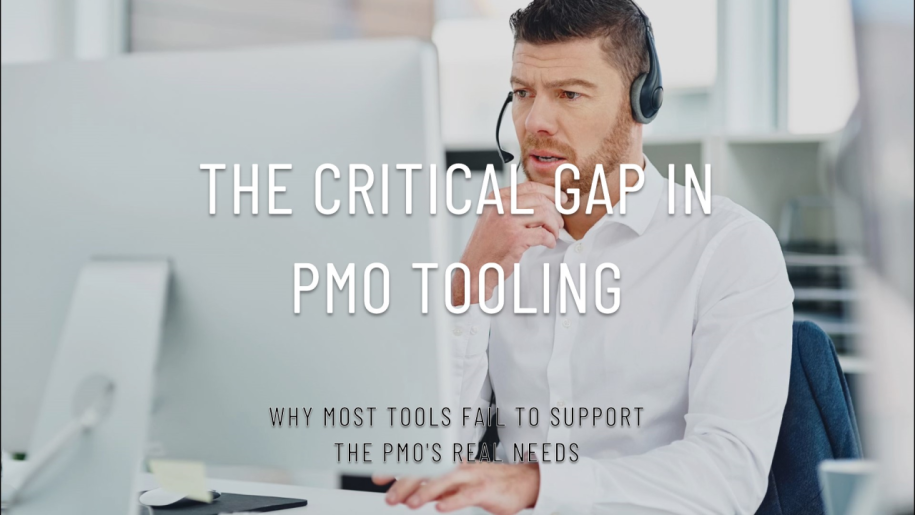In a landscape literally teeming with project management software, it’s surprising just how few of these tools truly serve the needs of the Project Management Office. Fully 99% of those imagined tools are completely designed to do the work of the project manager, focusing on granular task management rather than the overarching 14 strategic responsibilities of the PMO. While these highly praised task managers excel at tracking single tasks and their respective deadlines, they often leave project managers reaching for Excel sheets and PowerPoint presentations to pick up the slack. This results in a fractured experience where teams are forced to use a pile of different tools instead of enjoying a real one-stop solution.
Misaligned Focus: Task Management to Strategic Oversight
Most of the tools created for project management focus on one thing only, which is task management. These tools provide project managers with a method of doing nothing more than creating a sequence of tasks, assigning names next to tasks, and striking them through when they’re done. However, PMOs are required to perform much more than merely maintaining to-do lists. They are required to have a strategic overview, governance, resource management, and portfolio alignment—things task-oriented tools are clueless to provide. Consequently, most project managers tend to use these tools in combination with Excel sheets for managing budgets, timelines, and reports that these tools can’t handle well on their own.
Fragmented Toolsets: The Pain of Switching Between Multiple Platforms
In the wake of a plethora of project management software, too many project managers still resort to Excel, PowerPoint, and other ad-hoc solutions for managing their work. But why? This is most likely because the tools they are using often lack the required full-fledged functionality for dealing with complex projects. While they are strong in task tracking, they are weak in offering features in reporting, resource management, or governance. This sets into place a disjointed workflow where PMs are just forced to juggle between numerous tools to get a full picture of their projects. What should be an integrated experience becomes a patchwork of platforms that only leads to lowered productivity and adds nothing but unnecessary complexity.
Silos of Information and No Centralization
Multitude tools just lead to silos of information and henceforth nullify the capability of teams to have a single, centralized view of the projects. Task managers can centralize project data, but they often lack the ability to pull together data from across a portfolio of projects. This forces project managers to consolidate information from different sources manually, something a true PMO tool should do right out-of-the-box. The need of the hour is a PMO tool that pulls in all information of projects into one place, thereby providing useful insights at the strategic level—from resource allocation to risk management.
Poor Reporting and Analytics
Most project management tools come with base reporting, but most of those reports deal with operational metrics such as rate of task completion or timelines. This isn’t sufficient for the PMO. They want tools that give them the biggest and baddest analytics—those that will really let them drill into risk, portfolio performance, and resource utilization on all projects. On the other hand, though there is the need, the project managers are still exporting data to Excel and handcrafting reports, or they have to create pie charts and line graphs in PowerPoint to compile presentations for communication with stakeholders regarding project statuses. It is for this basic design flaw in the tools: they aren’t built for the PMO’s broader reporting needs.
Resource Management Across the Portfolio
As people would reasonably expect, resource management tools are usually designed to meet the specific needs of a project, whereas a PMO manages resources for an entire portfolio. Then, in the quest to address poor and jumbled-up resource balancing, the project manager is left with the burden of trying to apply external balancing tools, considering that the capability of task manager is weak in complexity to scale up. The outcome, as can be expected, will be inefficiency in managing bottlenecks and resource conflicts, a situation that can easily be addressed through an integral approach.
Governance and Compliance: The Missing Puzzle
Provide organizational governance standards for the project: Most project management tools provide minimal governance facilities, if any. As a result, a project manager ends up developing his or her own compliance tracking system—most often, in an Excel file, which adds to the fragmentation. A real PMO tool should provide end-to-end governance support, automate compliance checks, and make sure that the projects meet the required standards without any manual intervention.
Why the Industry Needs a One-Stop PMO Tool
The point remains that, while doing a good job at assisting a project manager to track what is happening on a day-to-day basis of a project, they in no way deliver what the PMO truly requires: a completely integrated strategic tool for the entire span of project management work. The constant toggling between numerous tools—be they Excel, PowerPoint, or different kinds of task managers—will always incur inefficiencies and a fragmented experience.
It is high time that organizations stop hyper-task managing and start looking for a solution that will provide a one-stop approach for PMO—thereby managing not just tasks but also high-level governance, resource management, and strategic alignment to drive genuine business value. And we all know that without a solution that can care for more than high-level governance but also resource management and ensure strategic alignment—kind of impractical at the time—it will surely have problems related to disconnected workflows and data silos.
